Stars, Stripes and Soccer: 10 takeaways from November USMNT Action: Part 1
By: Cameron Meyer
For the first time in over 285 days, Americans had the opportunity to see their men’s national team play this month, albeit, in two exhibition matches. That being said, the hype around two inconsequential matches against Wales and Panama was still very present.
With a squad with an average age of 21 years and 300 days and lined with European-based potential debutants like the “American Dream”, Giovanni Reyna, the USMNT was poised to attract even the most casual American soccer fans.
Those that tuned in saw a 0-0 draw to Wales in Swansea on Nov. 12 and a 6-2 win against Panama in Wiener Neustadt, Austria on Nov. 16. Outside of the concrete score lines, here’s what I think are the main takeaways from the November camp for the USMNT.
1. Gregg Berhalter needs to be cut some slack
In the short two years Gregg Berhalter has managed the USMNT, he hasn’t been a fan favorite. His ties to the higher levels of US Soccer through his brother didn’t do him any favors, and his alleged favoritism of MLS players has rubbed some Europhile fans the wrong way (despite the fact that most of those claims are nonsensical).
Now, I wouldn’t say Berhalter has been ideal up to this point; many tactical and personnel errors come to mind. But the one thing that cannot be disputed are his recruiting skills, which the U.S. severely lacked in the past.
I think all USMNT fans can remember the dreadful day Jonathan Gonzalez filed the one-time switch to play for the Mexican national team in 2018. He played throughout the U.S. youth ranks and was raised in California, yet chose to represent our neighbors to the south. Not only was this a dark day for the American midfield player pool, but it demonstrated the canyon-sized rift of communication and interest between the front office and the players.
Berhalter, thus far, has righted these wrongs ten-fold. Out of the 24 players selected to the squad in November, 8 were uncapped dual nationals prior to the two games. This doesn’t even include Sergiño Dest, who Berhalter somehow convinced to stay with the US after Dutch coach Ronald Koeman personally met with the fullback to discuss a switch to the Oranje.
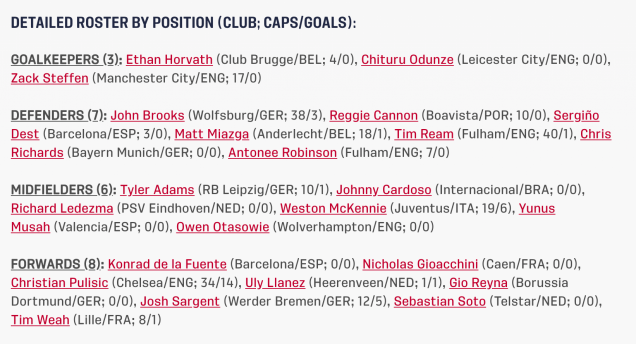
The epitome of Berhalter’s scouting ability, though, was the selection of Yunus Musah. Ask any American if they’d heard of Musah a month ago and I’d doubt there would be a single yes. A 17-year-old Valencia midfielder, who captained the U-18 England squad and just so happened to be born in New York City, fell under every US youth scout’s radar… but not Berhalter.
Many pundits finally bought a ticket on the ‘Musah hype-train’ after he became the youngest non-Spanish player ever to score for Valencia in early November, but Berhalter had already been riding it since 2019. According to Berhalter, he had been tracking Musah for over a year and had had lengthy conversations with the player and his family prior to his bursting onto the Spanish football scene.
So say what you want about Berhalter, but many of these promising players wouldn’t’ve been on the team sheet if not for his player management and scouting skills.
2. The high press will define this team
From camps prior, it’s been evident that Berhalter has wanted to play an attacking 4-3-3 setup, similar to the many dominant national teams and clubs across the world. A high press and quick possession-style soccer characterize the meta of champions in the past decade, and Berhalter wants the US to follow suit.
Unfortunately, due to a somewhat shallow player pool and tactical inefficiencies over the past couple years, Americans haven’t been able to see anywhere near a finished product to this plan. However, the games this past month might be signs for a brighter output in the future.
In the first minutes against Wales, the U.S. attacking press was far into the Welsh defensive third from kickoff. The striker (Lletget in this case) and a winger led the press to the backline while the opposite side winger and a center midfielder would press the second line.
This led to all sorts of problems for the Welsh defenders and goalkeeper Danny Ward, who at times scrambled to get the ball out of danger. Multiple chances came from this in the opening 45 in Swansea, notably in the 12th minute.
During a Welsh retreat to Ward, Konrad and Lletget cut the angle off to the two center halves while Reyna and McKennie stepped to the two Welsh center midfielders. With Konrad closing in, Ward was forced to send a ball wide to his left back and a Lletget block almost led to a chance for the US.
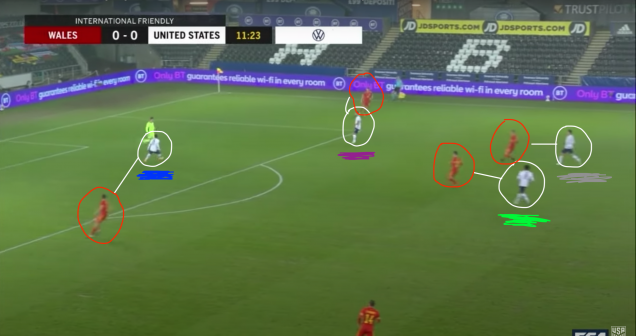
The U.S. high press’ effectiveness can also be seen in the 33rd minute of the same game, when McKennie, Reyna, Lletget, and Musah likewise created a “quadrilateral of death” where almost every option for the defender was squandered. The Welsh defender Lawrence is forced to make a foolish pass to a midfielder under pressure. This sequence almost and should’ve led to an opening goal from Konrad after a bad pass back to goal by midfielder Dylan Levitt.
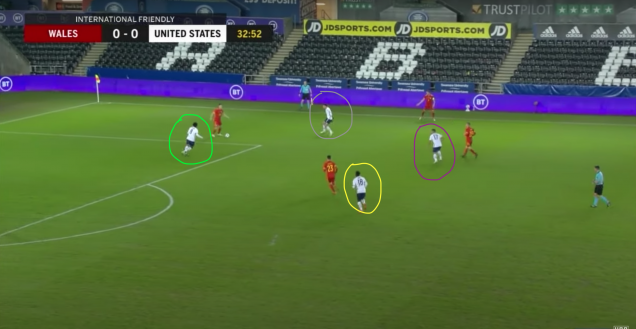
This press isn’t only launched when the ball is in the opponents defensive third, either. Through both games, when American players lost the ball, wherever it was on the pitch, they showed a fervent desire to win the ball back. McKennie, among others, was a big proponent of this. In both games, he ran like a dog without a leash (and I mean that in the most praise-worthy way possible) trying to challenge the opposition for the ball.
Against Panama, this led quite directly to a goal. In the build-up to Gioacchini’s first goal, Reyna’s through ball bounces off a Panamanian defender and falls into the feet of an opposition midfielder who tries to launch a counterattack. Reyna, partnered with McKennie, sprints towards the ball and sandwiches Carrasquilla, who coughs up the ball to Reyna. From there, the ball was played to Llanez on the wing, whose blocked shot puts a goal on a silver platter for Gioacchini.
This high-octane wavelength suits this group of players, and Berhalter’s high press system compliments their tenacity well. Although Berhalter does deserve some credit for recognizing this, it should be common sense. These players are hungry and have an unquenchable desire to win the ball; a coach would have to be sedated to not understand how a high-intensity system would allow these players to soar.
Expect fully to see this high press for years to come, no matter who the coach is.
3. This midfield will be exciting for years to come
Many USMNT fans, even going back to 2018, understood that our midfield had the potential to be a strong suit in the future. These games proved that this dream of a great midfield three for the US might finally come to fruition. Adams, McKennie and Musah were world-class a couple weeks ago with the trio getting the nod to start in both matches.
Adams demonstrated that the US might finally have a long-term solution to the aging of Michael Bradley, which he has been doing at club level for a while. Although there were shouts of Adams possibly playing as a Guardiola-esque inverted right back, coming into the midfield during possession, he demonstrated his unmatched ability as a number 6 destroyer during this camp.
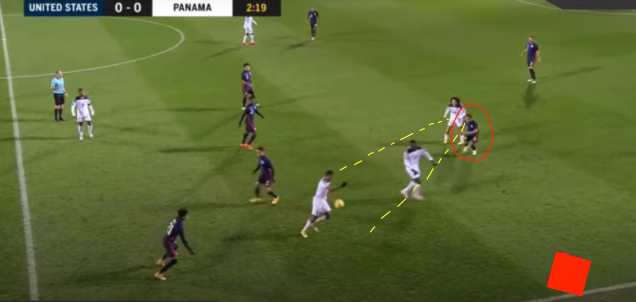
His positional intelligence and engine were on full display, tracking and intercepting passes and making smart challenges across the field. A great show of his positional intelligence came in the 3rd minute against Panama, when a missed tackle by Dest (who was playing left back), left two Panamanian players with room to run on the US’s left defensive flank. Adams noticed he was the last line of defense before the final third for Panama, and sprinted to make a tackle.
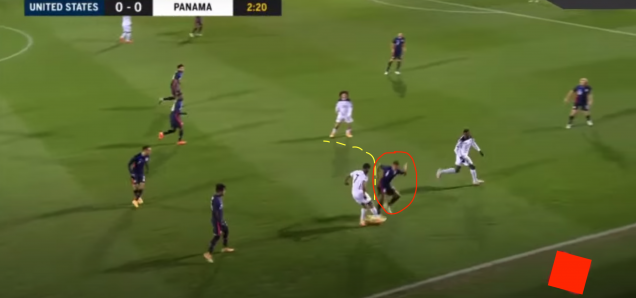
Many defensive midfielders given the task of being a destroyer can make the mistake of simply flying into challenges, but Adams didn’t falter here. He attacks the player in a way that cuts off the pass down the line and makes a hard challenge with the outside of his right foot. Although this might seem unorthodox, going in with the inside of his right or left foot could risk committing a foul considering the pace that he’s attacking the ball. Committing with the outside of his right, he makes a clean challenge and wins back possession.
Alike to Adams, McKennie shined in the two matches, operating as a forward-looking box-to-box midfielder. In past games for the USMNT, McKennie’s performances proved he is easily one of the starting 8’s, but always seemed to lack some passing skill and the ability to control a game. Now it’s not to say that he has turned his weaknesses to strengths, but he’s definitely shown strides of progress this past couple weeks.
Against Wales, for one, McKennie was nothing less than fantastic as it seemed like he owned that midfield. There were several times the midfielder would create attacks on his own, winning the ball in his own half and taking on two or more players to then play a terrific ball forward. Almost this exact sequence happened in the 2nd minute, the 48th minute, and most notably the 17th, which I think best reflects McKennie’s growing dynamism as a box-to-box midfielder.
With his back to a Welsh player in his defensive half, McKennie quickly spins away and sprints past him. As he meets another opposition player, he cuts inside and plays an inch-perfect ball to Dest on the right wing, launching a counterattack which arguably should’ve led to a shot on goal (0:20 on the Twitter video below). McKennie won the Man of the Match award voted by fans in this match, and he wholeheartedly deserved it.
Weston McKennie vs Wales (11/12/20)
— Matthew (@False_Fullback2) November 12, 2020
The last cog to the machine that was this midfield trio is full-blooded American (don’t listen to what the Brits have to say) Yunus Musah, who I kept having to remind myself is only 17 years old. Despite being the youngest in the starting 11 for both matches, and playing with teammates he’s only known for a week or so, his confidence on the ball was remarkable.
His ability to skate by defenders like traffic cones and his decision-making under pressure was reminiscent of a full-fledged veteran, so it’s scary to think how good he’ll be when he hits his 20’s and beyond. That being said, I’ll do a deeper dive into Musah’s play later in the column.
Watching this midfield do its thing should put a smile on any USMNT fan’s face, knowing that this is potentially the three that will guide US Soccer for a decade. As they say, all good things come in threes, and with this trio, that proverb doesn’t miss a beat.
4. The fullback conundrum is still a conundrum
U.S. fans came into this camp wondering whether it would be better to play Dest on the right and a natural left back on the left or to play Dest on the left in his unnatural position and Reggie Cannon on the right. After the two games I can confidently say that this problem has not been resolved in any way, shape or form.
The one pillar that USMNT fans can grasp firmly onto is that Dest is the best fullback on each side — it doesn’t matter where you play him. If there were any straggler nonconformists that didn’t believe this empirical statement before the camp, I doubt there are any left. On the right side against Wales, his overlap was unstoppable.
Almost every attack for the US ran through Dest and that’s not an exaggeration. Whether it was him pulling off some Brazillian-style trickery to beat a man, some interplay to find space or a teasing low-driven cross, the Welsh left side couldn’t contain the youngster. Just to top it off, a reverse elastico nutmeg on Daniel James in the 78th minute fully encapsulates Dest’s performance last Thursday.
https://twitter.com/FOXSoccer/status/1327276080118472704
On Monday, Dest played on the left against Panama. Being right-footed, this forced the fullback to play more of an inverted style, coming inside much more instead of hugging the sideline. Although Dest couldn’t be as directly involved in the attack at this spot, his combination play was still fantastic.
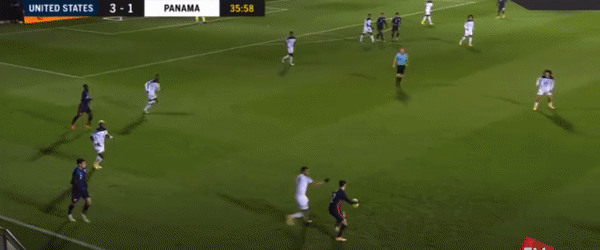
That being said though, Dest easily played the better game against Wales as he was able to whip in balls at pace. Unfortunately though, it isn’t as simple as playing Dest in his best position considering the less-than-favorable options at left back. Robinson, for one, looked pretty out of sorts in his start on Thursday.
He lacked the ability going forward that Dest gave on the opposite side, and his defensive game, which many thought could be made up for with his blistering pace, was pretty awful. Rabbi Matondo had his number for large lengths of the game, able to sneak by Robinson with ease. In the 11th minute, the left back placed an awful pass to a Welsh player. It would have been a goal if not for a McKennie’s highlight-reel track back and slide tackle.
On a more uplifting note, when Dest played on the left this past Monday, Cannon played well on the right. Defensively, he was astute minus a lack of concentration (the whole backline is responsible for this) during Panama’s second goal. Going forward, he wasn’t as dynamic as Dest, but his service was on point. His assist to Lletget is a testament.
So the full back issue isn’t settled as the same questions lie unsolved. Is it better to sacrifice Dest on the left to avoid a liability? O should the team just let Dest do his thing on the right while we hope and pray Robinson, Vines or Gloster turns into a prime Marcelo?
5. There are still questions at the right center back spot
Going from one question mark to another, Matt Miazga, who started both games at right center back against Wales and Panama, looked less than impressive. Looking for a quality center back partner for the World Cup hero John Brooks has been a problem for a while now and after the November camp, it has not alleviated.
The man who plies his trade in Anderlecht seemed to have left his defensive capability in Belgium as evidenced from his play at camp. In both games, there were moments where the opposition would break putting Miazga in a position to track a runner. In these similar sequences, Miazga makes a decisional blunder.
In the match against Wales in the 57th minute, Miazga decides to attempt to intercept the ball coming into his mark and misjudges the pass, leaving the Welsh attacker in behind. The defender then has to result to tactically fouling the attacker, getting a yellow card in the process.
Against Panama in the 12th minute, Miazga is affronted by an analogous series of plays. As the ball comes into his mark, Panama’s danger man José Fajardo, Miazga again lunges to intercept the ball only to be left out of position as he totally miscalculates the play. Luckily for Miazga, Fajardo slows up due to a bad touch, allowing for the American to catch up and make a block on an eventual cross. Against a better attacker, such as Hirving Lozano, he would be left for dead.
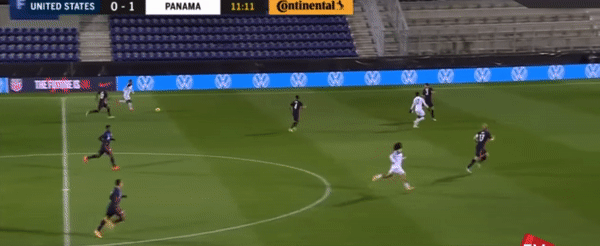
The other prime candidate for the right center back spot selected for camp, Chris Richards, was only given a ten-minute cameo against Panama. Apparently, even if a player starts for Bayern Munich in the Bundesliga, he’s not good enough to start for the USMNT against Panama (compulsory eye-roll). Although he looked promising, his time on the pitch was not sufficient enough to conclude about his position in the US squad.
That being said, Brooks’ partner still remains a giant question mark on the team sheet. On the bright side, the guys that will be called into the December camp, mostly being MLS players like Long, Zimmerman and McKenzie, will fight knowing that the spot is up for grabs.
Featured image courtesy of MLS Soccer.
